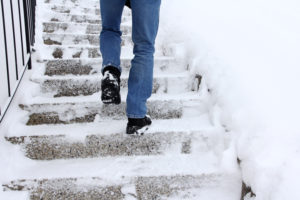
The risk of slipping and falling in an accident rises exponentially in colder weather. Ice, snow, and sleet can create treacherous — even potentially deadly — conditions for pedestrians, as sidewalks and steps become difficult if not impossible to walk on.
What if you rent? The sidewalks and parking lots outside your house or apartment building should be kept free of ice and snow, and so should the steps. It’s part of the duty of whomever is responsible for maintaining the building.
But what if you slip and fall due to ice or snow on the sidewalks, walkways, or steps? Who is responsible?
Responsibility for Maintaining Building Safely
There are some general principles in liability and responsibility in buildings. Ultimately, owners of buildings have what courts term “a duty of care” to keep their buildings well maintained and safe for tenants. In the case of snow, ice, and sleet, that means making sure all the areas tenants would reasonably walk on are kept clear of snow, ice, and sleet. It also means sanding properly if conditions could change.
There are two other elements in assessing responsibility and liability. Owners not only have a duty of care, they have to know that the area is unsafe (or the conditions need to be deemed such that a reasonable person would have known), and have had sufficient time to shovel, de-ice, and sand.
Now, if you slip and fall due to the fact that ice and snow wasn’t removed from walkways and steps around your building, several parties might be at fault. It depends on the system for snow and ice removal.
When Is the Property Owner at Fault for a Slip and Fall on an Icy Walkway?
The owner might be at fault if he failed to remove the snow or ice if he was personally responsible. If the owner hired a property manager to oversee maintenance of the building(s), the property management company could be at fault if they failed to either remove it or hire someone to do it. If either the property manager or owner engaged a super or a grounds crew to perform the shoveling, de-icing, and sanding, and they failed to do so, they could be at fault. If the owner failed to engage either a property manager or super/grounds person, or failed to train them, the owner might be at fault.
But slip and fall cases can, of course, be complex. Supers and grounds crew can argue that they were not given the instruction, or not properly trained. All parties could potentially argue that the snow or ice had only recently occurred, and that didn’t have sufficient time to clear it.
All these parties could also argue, unfortunately, that the person who slipped and fell was at fault. If they didn’t know that the temperature was low enough to cause ice, for example, or hadn’t had time to clear it, they may argue that you knew the area was unsafe but walked on it anyway, or didn’t wait for it to be cleared. They may even argue that you wore improper footwear for cold and icy conditions, or were walking too fast.
Do You Need a Slip and Fall Attorney in New York or New Jersey?
Slip and fall cases can be complex in terms of determining who is at fault. You need an experienced attorney on your side to make sure you receive fair treatment and just compensation for your injuries.
NY & NJ slip and fall lawyers at Kantrowitz, Goldhamer & Graifman have been investigating and litigating cases involving negligence on the part of landlords and property managers in New York and New Jersey for more than four decades.
We will fight to see that you receive just compensation. For a complimentary case review, call us today toll free at our Bergen County or Rockland County offices.
Additional Resources:
- National Safety Council. Fall-prevention Measures Can Keep Older Adults Independent. https://www.nsc.org/home-safety/safety-topics/older-adult-falls.
- The Zebra Winter Weather Preparedness. https://www.thezebra.com/resources/car-insurance/winter-weather-preparedness/.
